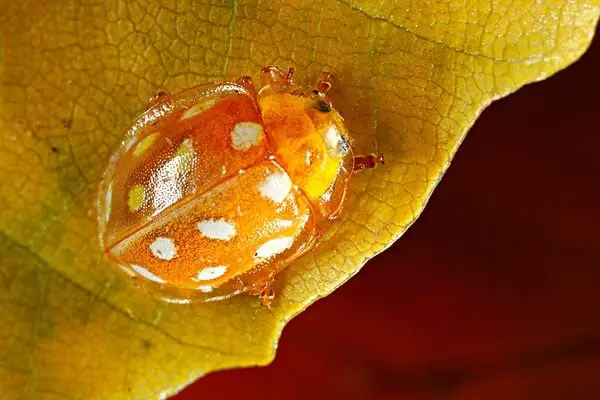When you think of a Ladybird, the first thing that comes to mind is a small red brightly colored insect with black spots on its body. Here’s what the spots on ladybugs mean.
This is the image embedded in our minds from childhood. Helped along by the popular Ladybird books which we used to read back when we were children – remember those? You can even still get them on Amazon.
That’s the most common vision of a Ladybug or Ladybird, but there are many variations to this. One thing though is common among most of the species in the Ladybug family – the spots on its body. Have you ever wondered how the spots on Ladybugs came about and what their purpose is?
So, what do the spots on a Ladybug mean?
Spots on a Ladybug function as a defense mechanism to deter predators. Its colorful body along with the spots warn predators that this creature will not taste pleasant if eaten, thus keeping the Ladybug safer. Their spots and colors have evolved over time and passed on genetically through the species.
But that can be very different from what we think they mean…
Ladybugs are one of the most fascinating creatures of the beetle family. The difference in their bodies is what makes them a family of bugs that is noteworthy. So, let’s get to know more about Ladybugs and their spots. It’s an interesting topic.
But Is It Even a Ladybug?
Why Ladybugs Have Spots
There are many types of Ladybugs with a variation of colors ranging from scarlet to yellow to orange and even through to white or black.
Not all of them have black spots either. Some have white spots and some don’t have spots at all! You can learn more about the spotless Ladybug later on in this article.
The whole purpose of the Ladybug being brightly colored with spots is to ward off predators. The Ladybugs want to let their predators know that they taste bad and could even be poisonous. This serves as a warning sign for the predators and keeps them away.
Similar defense mechanisms are used by many other animals in the animal kingdom. The bumblebee presents a bright yellow color with black stripes which serves as a warning for its attackers, visible from a distance too.
The attackers are forewarned about the danger as bumble bee stings could be potentially poisonous or fatal to them.
Ladybug spots and colors denote danger to predators
The same applies to the Ladybug. It releases a foul-smelling and toxic alkaline substance from its body which tastes very bad to most birds and other potential predators.
It’s known to be mildly poisonous to some smaller creatures, but not poisonous enough to kill most predators. Likely, it would make them sick for a while – depending on the size of the predator and how many they eat.
Once the predator, such as a bird, eats its first Ladybug, it experiences a nauseous feeling from the toxins.
The next time it sees the similar brightly colored body of another Ladybug with spots, it remembers what it went through and does not attack. This is a natural phenomenon I wrote previously about, known as Aposematic Coloring. and forms one of the Ladybugs Five Defense Mechanisms.
Having said that, there are still plenty of creatures that will hunt and eat Ladybugs.
Now we know what the spots’ defensive function is, you might wonder how Ladybirds actually got these spots and what makes them different from each other. Let’s read on to find out.

Did You Know…
A Group of Ladybugs is called a ‘Loveliness of Ladybugs’
Find out more Surprising Ladybug Facts
How Ladybugs Got Their Spots
The Ladybug gets its number and color of spots through genes handed down over thousands of generations, mostly evolved even before dinosaurs were on earth and even some bacteria. These mutations over time have settled into the 5000+ types we know of today.
The spots have become one of the main forms of identifying the specific species to which a Ladybug belongs.
Different species of Ladybugs
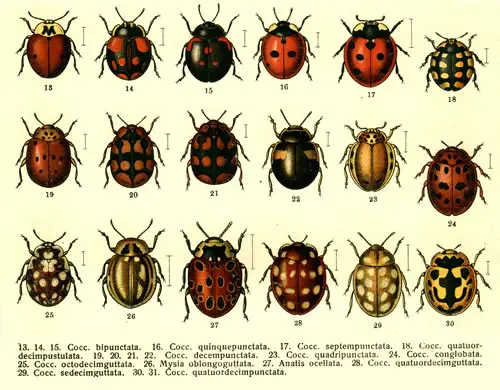
The above image shows the different species in the Ladybug family. You can see that the color of the body changes from red to yellow and through to orange.
But wild variations mean that even white Ladybugs, Grey Ladybugs, and Black Ladybugs exist too. The number, shape, and color of the spots on their bodies have changed and evolved gradually from species to species.
As you can also see from the picture, not all Ladybirds have spots. They could also have different markings such as stripes, streaks, and other shapes.
The most common type of Ladybug species (and the most notorious) is the Asian Ladybug, but a popular well-liked (cute) Ladybug is the Coccinella septempunctata.
This type of Ladybug has seven spots on its body. You will find your typical Red Ladybug with its scarlet body and black spots in this family. Although, this cute and common variety is now seriously under threat from this species!
A particular species cannot be predicted just by the number of spots on its body. There could be many sub-species that have the same number of spots. Many factors such as the sub-species, plus shape, and color of the body help determine the exact final variety of the Ladybug.
The number of spots and their location is decided for a particular species and do not really visibly change over time, but may evolve further and slowly over hundreds, if not thousands of years.
They don’t gain more spots or lose spots over time unless via further genetic mutation. Let’s see when these spots actually develop within the life cycle of the Ladybug.
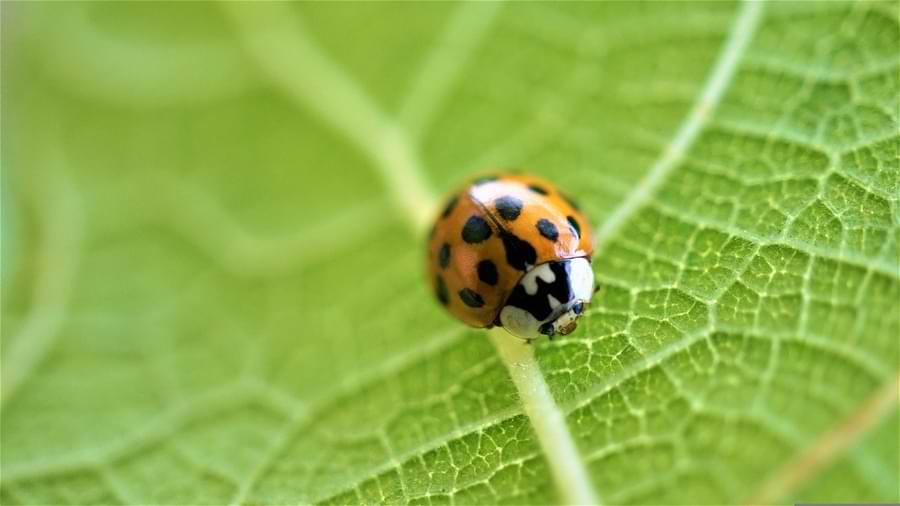
Are Ladybugs Born With Spots?
So to confirm for you whether Ladybirds have spots when they’re born. I can tell you Ladybugs are not born with spots, they develop them, but they are predetermined. The genes already decide what species of ladybug they are going to be, and therefore they have inherited the spots already. They just don’t appear immediately.
This is proven by the following image of a newly hatched Ladybug (I called him Phillip!).
The image shows a sequence of photos I’ve taken, about five minutes apart, and you can see how the Ladybug visually develops its spots.
By the way, Phillip is alive and well, last seen on the rosebush in my backyard!

When Ladybug Spots Develop
In order to know exactly how the predetermined spots develop, we need to work through the different stages of the life cycle of a Ladybug.
The Ladybug starts its life as an egg. It then hatches out of the egg and is called Larva. Larvae have black and grey bodies.
Although the number of spots a Ladybug will have is already pre-determined through genetics.
At the Larva stage of the life cycle it does not develop spots, but rather stripes – or markings along its body that indicate what type of spots it will develop later.
Next, these larvae develop into a pupa, and finally, they become fully grown adult Ladybugs.
The larval stage is where one can specifically identify the Ladybug with the number and types of markings it has – even though they may be represented in different forms along its body.
At this stage, it has an elongated spine – which kind of makes it look like a tiny black alligator.
But to the untrained eye, it’s still hard to tell what type of Ladybug this will be, or exactly how many spots it will have.
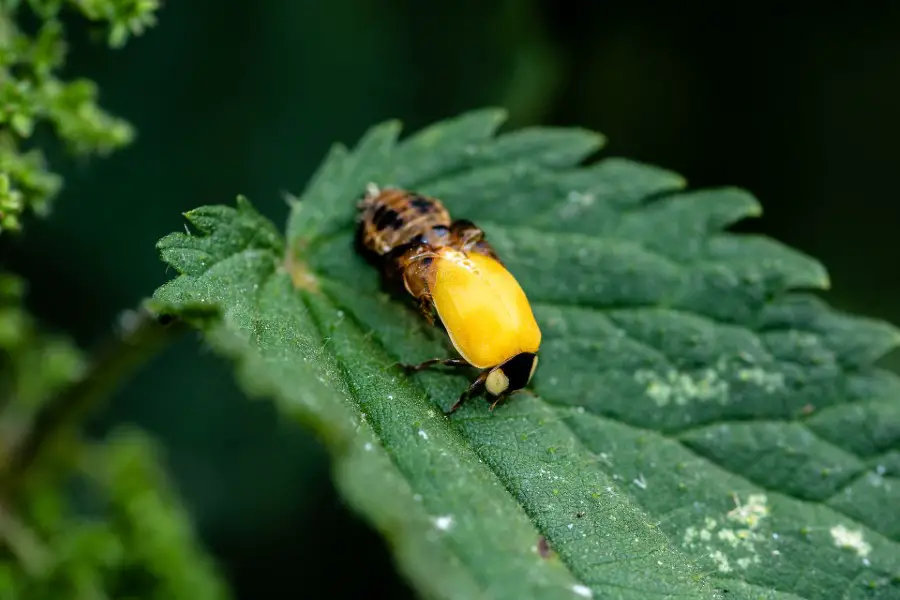
So Ladybugs are not born with spots on their bodies. It is not until the adult finally appears from the pupa that the number of spots becomes clearer.
Even then, the spots only begin to appear on their new shell within the first 24 hours, so it still takes a little time.
Quick Quiz…
How High Can a Ladybug Fly?
60′ 600′ 1600′ 2600′ 3600′
Find the answer HERE

Many people have a view borne out of myths about the spots on a Ladybug, which may not be true. Let’s look at what these are.

Find out if Ladybugs Sleep Here!
Myths and Beliefs About Ladybird Spots
Some say the number of spots on a Ladybug denotes its age. This is not at all true, let me give you an example.
According to this theory, the 24-spotted Ladybug should be 24 years old. This cannot be possible as the average lifespan of a Ladybug is 2 to 3 years.
This demonstrates that the number of spots on a Ladybug does not denote its age.
I wrote about many other myths, signs, symbols, and meanings surrounding the number of spots on a Ladybug, from all around the world. These include the following;
- If a Ladybug lands on you, the number of spots on its body is an indicator of how many children you will have in the future.
- If a Ladybug lands on you, you will soon receive money. The amount you receive will be the same as the number of spots on the Ladybug.
- Many farmers around the world believe the number of spots on a Ladybug predicts the outcome of the next harvest. If the Ladybug seen has less than seven spots on its body, the harvest will be good.
You can believe whatever you want about the spots on a Ladybug. But – what if a Ladybug with no spots lands on you? Does it mean none of the above would come true?
Joking aside, let’s see if these kinds of Ladybirds actually exist.
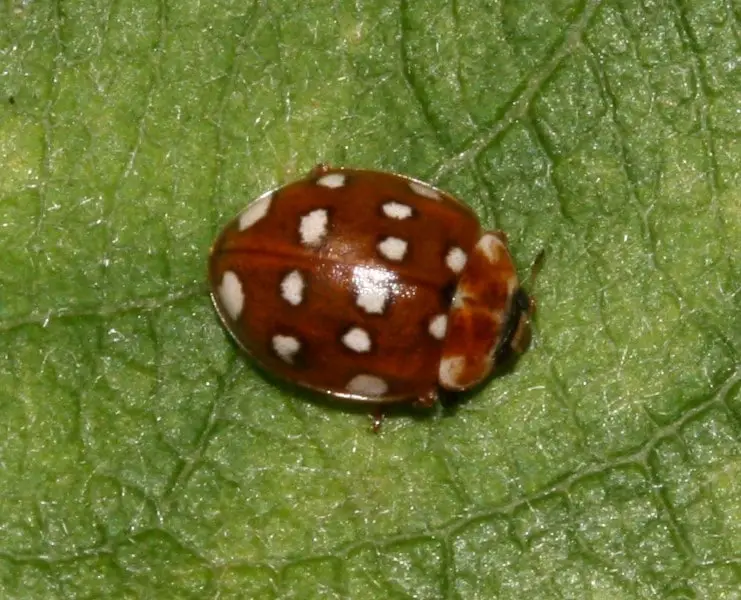
Ladybirds Without Spots
The Coccinellidae is a whole family of Ladybug species. It contains Ladybugs in all manner of colors and markings.
You can also find Ladybugs without any markings on their bodies, so their bodies are plain in color.
The spotless Ladybugs belong to the Cycloneda family. Following are the Ladybugs which belong to this family;
- Cycloneda
sanguinea – Commonly found in California, USA - Cycloneda
polita – Commonly found in California, USA - Cycloneda
munda – Commonly found in Texas, USA
So, how can you differentiate between different types of spotless Ladybugs? The markings on their heads help you identify each individual species.
A spotless Ladybug is the same as your average Ladybug and is no more harmful or poisonous than any other Ladybug in the Ladybug family.
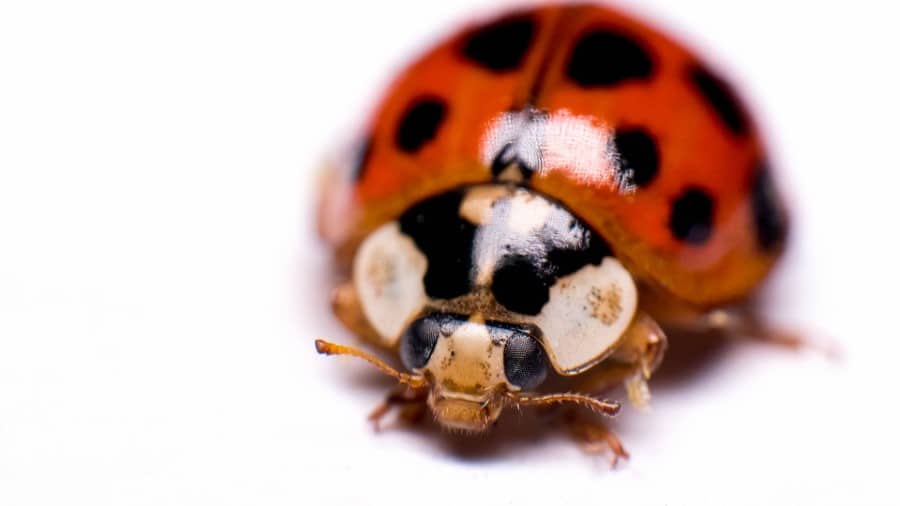
What The Spots on Ladybugs Mean – Conclusion
Now you know how diverse the Ladybug species is because of its appearance, especially with its spots. This kind of variety makes it a family of species that for the most part is attractive to the eye.
Although you would have thought of the Ladybug as a plain old beetle with a red body and black spots, ladybugs can have many colors belonging to many families and sub-families, with additional colors such as black, brown, grey, and white. Mother nature works in mysterious ways.
Next time you see a Ladybug, take a closer look and try to identify which species it belongs to.
You might even come across a species other than the most common types of Ladybugs found around. Who knows, maybe you found a new type of Ladybug – previously undiscovered!
If you enjoyed this article please share it, and don’t forget to check out my resource page for some great Ladybug gifts, as well as some free educational resources for home and classroom use.
Related Questions
What is the highest number of spots on a Ladybug? A type of Ladybug species named Subcoccinella 24-punctata can have up to 24 spots on their bodies.
Do all spotted Ladybugs have black spots? No, Ladybugs can have spots, stripes or streaks in white, orange, yellow, and other colors. For example, the twice-stabbed Ladybug, scientifically known as Chilocorus stigma has a black body with two red spots.
Is a Ladybug a female? Ladybugs are both male and female. To the untrained eye, it is very difficult to determine which is which. There are ways to tell, for example, a male Ladybug tends to be smaller with slightly more hair. See this article for more details.



